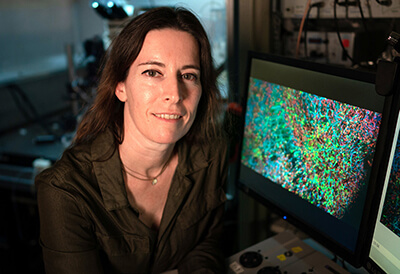PROFESSOR STERN IS LEADING THE SEARCH FOR CLUES THAT WOULD ENABLE MORE PRECISE PREDICTIONS OF PARKINSON’S DISEASE ONSET FOR AT-RISK PATIENTS
ABOUT PROFESSOR SHANI STERN
Professor Shani Stern is a researcher for the Sagol Neurobiology Department and leading a lab that uses electrophysiology and molecular biology methods to find disease mechanisms. She uses her expertise in this area to delve into the biological mysteries of the brain that most intrigue her. Stern received her B.Sc. degree in electrical engineering from Tel Aviv University. She went on to receive her Ph.D. in physics from the Weizmann Institute in Israel. While there, Stern collaborated with the neuroscience department. She later joined the Salk Institute for Biological Studies as a postdoctoral fellow, and became a member of the Engman Laboratory for Schizophrenia Research.
During her postdoctoral training, Stern used induced pluripotent stem cell (iPSC) technology to study changes in the physiology of different brain disorders: bipolar disorder, schizophrenia, Parkinson’s disease, autism spectrum disorder, epilepsy, and intellectual disability caused by a few different mutations. iPSC technology provides the ability to reprogram adult mature cells into pluripotent cells, allowing differentiation into multiple cell types. Importatnly, iPSCs can be used to derive brain cells from patients with diseases where the genetic changes are complex and sometimes unknown. Additionally, Stern can produce targeted mutations in iPSCs which allow these cells to be used for functional analysis of variations in the genome.
WHAT IS ELECTROPHYSIOLGY?
Electrophysiology (EP) is a method of understanding the wayelectric signals are generated in cells and tissues in the body. EPstudy is used to understand the physiology and function of cells,and in neuroscience - neurons. It can be used to understandspecific mechanisms that may be altered in diseased neurons. Neurons connect to each other through electrical impulses. When a neuron is studied using EP the impact of surrounding neurons can be observed by measuring the currents enteringthe cell through synaptic inputs. An increase or decrease in thesynaptic currents can point to dysfunction in the synapses andcan result in neuronal atrophy
PREDICTING THE ONSET OF PARKINSON’S DISEASE FOR THOSEPREDICTING THE ONSET OF PARKINSON’S DISEASE FOR THOSEAT RISK AND EXPLORING POTENTIAL TREATMENT METHODS
Professor Stern uses iPSC technology to derive neurons from Parkinson’s patients that can be observed as they develop andage. These derived neurons have the exact same geneticmodifications as the patients they are derived from and istherefore relevant both to Parkinson's disease caused bymutations as well as to idiopathic Parkinson's disease. Thisenables Stern to witness pathological changes that occur asthe disease progresses. The method has led to observationsof a reduction in synaptic connectivity in the patients' neurons- even before a patient would be showing symptoms. Parkinson's disease patients have a severe neuronal cell deaththat is more specific to areas in the brain that are compacted with dopaminergic neurons, such as the substantia nigra parscompacta. The cause of this excess cell death remains unclear, but certain neuronal pathologies occur before mortality suchas aggregation of proteins in these neurons that are termed "Lewy Bodies"
Using the cell lines she has created, Professor Stern is growing 3D structures that resemble the structure of the substantia nigra pars compacta called organoids. These serve as a novel platform for testing possible treatment. Professor Stern hasstarted experiencing with modulators of the dopaminereceptors, as well as drugs that are given to Gaucher patients, and is now testing for improved neuronal survival in hertreated organoids. This scheme is used together with electrophysiology and extensive analysis of RNA sequencing to find pathways that are altered in the disease and can be further treated.
FUTURE RESEARCH POTENTIALFUTURE RESEARCH POTENTIAL
Professor Stern’s use of iPSC has allowed her to create cell lines from patients with different genetic markers for Parkinson’s along with lines from patients who’s Parkinson’s developed sporadically. By comparing the development of the disease among these different patient groups she can observe the common traits to the different types of Parkinson's disease. Further exploring the cell lines through genetic sequencing allows her to also explore the roles other genes - not directly related to Parkinson’s disease - may be playing in the process. Using RNA sequencing Stern has found that there are several unrelated genes that are severely dysregulated in the cell lines of Parkinson’s patients. Strikingly these include many types of collagen genes. Professor Stern is exploring the possibility of growing skin cell lines as well as skin or ganoids in order to further investigate this relationship, and in the hope of building an effective prediction algorithm that would allow the prediction of disease onset and severity at the prodromal stage.
Websiite: https://www.shanistern-diseasemodelinglab.com



